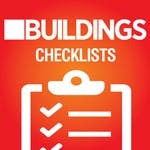From the sold-out floor of IRE 2019, Janelle Penny speaks with Mike DuCharme about all things roofing.
[Begin transcript]
Janelle: This is Janelle Penny, senior writer for BUILDINGS magazine. I’m here at the International Roofing Expo in Nashville, on the buzzing show floor.
And I’m here today with Mike DuCharme, who is the outgoing chairman of the EPDM Roofing Association, also known as ERA.
ERA is the trade association that represents the manufacturers of EPDM single-ply roofing products, including Firestone Building Products, Johns Manville and Carlisle Construction Materials. And in addition to serving as the chair of ERA this year, our guest is vice president of product marketing at Carlisle as well.
Hi, Mike.
Mike: Hi there, Janelle.
Janelle: So, you’ve been the chair of ERA for two years now, right?
Mike: That’s correct.
Janelle: Great. What changes have you observed in the industry as you’ve been chair?
Mike: We’ve seen certainly a lot of changes in the industry. You know, I’ve been in the overall roofing industry for over 35 years in roles ranging from technical roles to sales roles to product development and product marketing.
Rather listen to the podcast instead?
BUILDINGS Podcast
Roofing Trends Seen by EPDM Roofing Association
[podcast]
Janelle Penny speaks with Mike DuCharme, of the EDPM Roofing Association (ERA), at the IRE Expo 2019. Mike talks about the many changes he’s seen over his 35 years in the industry, as well as current trends that have popped up. Listen now >>
And we’ve seen a lot of changes. We’ve seen a higher focus on roofing performance, desire for roofs to last longer. You know, where as in years past, people might have been tolerant with a roof that lasted 10 or 15 years. Now, the expectation is that a roof will last 20, 30+ years.
It’s also been a lot of push and trend towards increased energy efficiency, trying to have roofs that help the building conserve energy. So, there has certainly been a drive towards putting more insulation on the roof to improve the efficiency of buildings.
Janelle: Great. What do you think is driving that?
Mike: I think it’s a dollars and cents issue. As energy costs continue to increase, people are looking at how they can get more out of those dollars.
Janelle: Makes sense. And resilience has been a focus for the association too, right?
Mike: Resilience has been a big focus in the last couple of years for the EPDM Roofing Association.
Janelle: Great. What made you decide to take that on as an organization?
Mike: Well, what we saw, certainly there has been a lot of dialogue on climate change and its impact on building performance. We’re seeing a lot of negative impacts – storm damage, flooding, things like that – that have impacted buildings that isn’t really addressed in some of the current codes and standards.
[Related: Biggest Risks Impacting Your Building in 2019]
So, we thought that this was an important area to dig into and to try to help the industry by providing information. In years past, there was a lot of discussion on the topic of sustainability. And sustainability is similar in that that’s a focus on how to make buildings more energy efficient, how to make building materials be used more efficiently.
But it didn’t have as much focus on roof performance, especially in severe conditions. So, that’s where resilience comes in.
Janelle: Sure. How do you answer clients who say that they can’t afford to create a resilient roofing system?
Mike: Well, it is a question of your current spending dollars versus the future. What the National Institute of Building Sciences has determined is while you might spend some dollars today, for every dollar spent today mitigating and potentially preventing damage to the roof, you can save $11 in the future.
Janelle: Wow.
Mike: So, it’s a big savings. You gotta spend a little bit more upfront in some cases, but you’re going to get a much better performing building out of it.
Janelle: Excellent. So, let’s talk about tools. What resources are out there to help people create resilient roofs?
Mike: There are a lot of good articles. ERA has taken the lead in presenting information in a lot of the architectural forums on that topic.
We’ve also developed a guide that’s available on the website, EDPMroofs.org, that pretty much goes into the issue in detail as to the costs that are potentially occurring due to climate change, some of the steps you can take to mitigate and potentially prevent damage to your building, some of the enhancements you can make to a roof system to make sure it will resist, whether it’s high winds or flooding or whatever it might be.
Janelle: Great. And you have the new report out, “Building Resilience, the Roofing Perspective,” right?
Mike: That’s correct.
Janelle: Great. Can you tell me a little more about what’s in it and what kind of conclusions you came to as you were researching it as an organization?
BUILDINGS Checklist
Build Your Roofing File - Exclusive Checklist
As a facilities manager or owner, having organized, updated maintenance and financial records of crucial components of your building is important. Especially if something happens and you need this information available quickly. Download yours now >>
Mike: Yeah. It certainly gives a lot of the good background information. But I think the meat of it is really getting into the enhancements you can make to a roof system to ensure that it’s going to perform long-term.
And some of them are very basic. It can be things like the inclusion of a cover board or a thicker membrane to ensure that the roof can resist potentially wind-blown debris or hail damage, elements like that.
So, sometimes it’s just little tweaks to the roof system that’ll really enhance performance.
[On topic: Roofing’s Nine Roles in Resilience]
Janelle: Great. And what trends do you see in 2019? What are you looking at going ahead?
Mike: Well, there’s certainly going to be this ongoing focus on resilience. In general, even beyond resilience, one of the trends we’re focused on are issues related to the workforce and how we can help mitigate the labor shortage by providing more efficient roof systems. So, there’s a real drive to improve the technology to make sure they’re not even tough and storm resistant, but they can also be put down more easily.
Janelle: Excellent. Mike, thanks for joining me again today. This has been Janelle Penny at the International Roofing Expo. Please be sure to check out the rest of our podcasts at buildings.com.
[End transcript]
More IRE coverage:
About the Author
Janelle Penny
Editor-in-Chief at BUILDINGS
Janelle Penny has been with BUILDINGS since 2010. She is a two-time FOLIO: Eddie award winner who aims to deliver practical, actionable content for building owners and facilities professionals.


